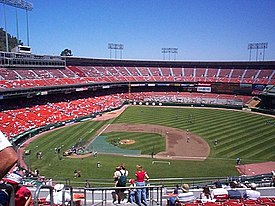Candlestick Park
| "The Stick" | |
|
|
|
| Former names | Harney Stadium (1956–1959) Candlestick Park (1960–1995, 2008–2013) 3Com Park at Candlestick Point (1995–2002) San Francisco Stadium at Candlestick Point (2002–2004) Monster Park (2004–2008) |
|---|---|
| Location | 602 Jamestown Avenue San Francisco, California 94124 |
| Coordinates | 37°42′49″N 122°23′10″W / 37.71361°N 122.38611°WCoordinates: 37°42′49″N 122°23′10″W / 37.71361°N 122.38611°W |
| Owner | The City and County of San Francisco |
| Operator | San Francisco Recreation & Parks Department |
| Capacity | 43,765 (1960) 63,000 (Baseball) 69,732 (Football) |
| Field size |
Left field 330 ft (1960), 335 ft Left-center field & Right-center field 397 ft (1960), 365 ft Center field 420 ft (1960), 400 ft Right field 330 ft (1960), 328 ft Backstop 73 ft (1960), 66 ft |
| Surface |
Bluegrass (1960–1969, 1979–2013) AstroTurf (1970–1978) |
| Construction | |
| Broke ground | August 12, 1958 |
| Opened | April 12, 1960 |
| Closed | August 14, 2014 |
| Demolished | February 4 – September 24, 2015 |
| Construction cost | US$15 million ($121 million in 2017 dollars) |
| Architect | John Bolles & Associates |
| Structural engineer | Chin and Hensolt, Inc. |
| General contractor | Charles Harney Co. |
| Tenants | |
|
San Francisco Giants (MLB) (1960–1999) San Francisco 49ers (NFL) (1971–2013) Oakland Raiders (AFL) (1960–1961) |
|
Candlestick Park was an outdoor sports and entertainment stadium located in San Francisco, California, in the Bayview Heights area. The stadium was originally built as the home of Major League Baseball's San Francisco Giants, who played there from 1960 until moving into Pacific Bell Park (since renamed AT&T Park) in 2000. It was also the home field of the San Francisco 49ers of the National Football League from 1971 to 2013. The 49ers moved to Levi's Stadium (located in Santa Clara, California) before the beginning of the 2014 NFL season.
The stadium was situated at Candlestick Point on the western shore of the San Francisco Bay. (Candlestick Point was named for the "Candlestick birds" that populated the area for many years.) Due to its location next to the bay, strong winds often swirled down into the stadium, creating unusual playing conditions. At the time of its construction in the late 1950s, the stadium site was one of the few pieces of land available in the city that was suitable for a sports stadium and had space for the 10,000 parking spaces promised to the Giants.
The surface of the field was natural bluegrass, but for nine seasons, from 1970 to 1978, the stadium had artificial turf. A "sliding pit" configuration, with dirt cut-outs only around the bases, was installed in 1971, primarily to keep the dust down in the breezy conditions. Following the 1978 football season, the artificial turf was replaced with natural grass.
When the New York Giants arrived in San Francisco in 1958, they played their home games at the old Seals Stadium at 16th and Bryant Streets. As part of the agreement regarding the Giants' relocation to the west coast, the city of San Francisco promised to build a new stadium for the team. Most of the land at Candlestick Point was purchased from Charles Harney, a local contractor. Harney purchased the land in 1952 for a quarry and industrial development. He made a profit of over $2 million when he sold the land for the stadium. Harney received a no-bid contract to build the stadium. The entire deal was the subject of a Grand Jury investigation in 1958.
...
Wikipedia



